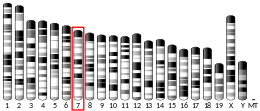BCL3
BCL3B세포 림프종 3인코딩 단백질은 인간에게 BCL3 유전자에 의해 암호화된 단백질이다.[5][6]
이 유전자는 원생종 유전자다.B세포 백혈병의 일부 사례에서 면역글로불린 알파로쿠스로의 변환으로 확인된다.이 유전자에 의해 암호화된 단백질은 7개의 앤키린 반복을 포함하고 있는데, 이는 I 카파 B 단백질에서 발견된 것과 가장 밀접한 관련이 있다.이 단백질은 NF-카파 B 호모디머와의 연관성을 통해 활성화되는 전사적 공동 활성제의 기능을 한다.이 유전자의 발현은 NF-카파 B에 의해 유도될 수 있으며, NF-카파 B는 p50 NF-카파 B의 핵거주를 제어하는 자동 관측 루프의 일부를 형성한다.[7]
BCL2, BCL5, BCL6, BCL7A, BCL9, BCL10과 마찬가지로 림프종에서도 임상적 의의가 있다.
상호작용
BCL3는 다음과 상호작용하는 것으로 나타났다.
임상적 유의성
BCL3 유전자의 유전적 변화는 말기 알츠하이머병(LOAD)과 만성 림프구 백혈병과 연관되어 왔다.알츠하이머 환자의 뉴런에 β-아밀로이드 축적을 통해 NF-bB가 활성화되어 BCL3 발현을 유도한다.[16]BCL3의 표현력이 증가된 것이 LOAD를 가진 환자의 뇌에서 관찰되었다.[17]
참조
- ^ a b c GRCh38: 앙상블 릴리스 89: ENSG000069399 - 앙상블, 2017년 5월
- ^ a b c GRCm38: 앙상블 릴리스 89: ENSMUSG000053175 - 앙상블, 2017년 5월
- ^ "Human PubMed Reference:". National Center for Biotechnology Information, U.S. National Library of Medicine.
- ^ "Mouse PubMed Reference:". National Center for Biotechnology Information, U.S. National Library of Medicine.
- ^ Wulczyn FG, Naumann M, Scheidereit C (August 1992). "Candidate proto-oncogene bcl-3 encodes a subunit-specific inhibitor of transcription factor NF-kappa B". Nature. 358 (6387): 597–599. Bibcode:1992Natur.358..597W. doi:10.1038/358597a0. PMID 1501714. S2CID 4363340.
- ^ Ohno H, Takimoto G, McKeithan TW (March 1990). "The candidate proto-oncogene bcl-3 is related to genes implicated in cell lineage determination and cell cycle control". Cell. 60 (6): 991–997. doi:10.1016/0092-8674(90)90347-H. PMID 2180580. S2CID 1919787.
- ^ "Entrez Gene: BCL3 B-cell CLL/lymphoma 3".
- ^ a b c d Dechend R, Hirano F, Lehmann K, Heissmeyer V, Ansieau S, Wulczyn FG, et al. (June 1999). "The Bcl-3 oncoprotein acts as a bridging factor between NF-kappaB/Rel and nuclear co-regulators". Oncogene. 18 (22): 3316–3323. doi:10.1038/sj.onc.1202717. PMID 10362352.
- ^ a b c Na SY, Choi JE, Kim HJ, Jhun BH, Lee YC, Lee JW (October 1999). "Bcl3, an IkappaB protein, stimulates activating protein-1 transactivation and cellular proliferation". The Journal of Biological Chemistry. 274 (40): 28491–28496. doi:10.1074/jbc.274.40.28491. PMID 10497212.
- ^ "Molecular Interaction Database". Archived from the original on 2006-05-06. Retrieved 2012-05-08.
- ^ a b Thornburg NJ, Pathmanathan R, Raab-Traub N (December 2003). "Activation of nuclear factor-kappaB p50 homodimer/Bcl-3 complexes in nasopharyngeal carcinoma". Cancer Research. 63 (23): 8293–8301. PMID 14678988.
- ^ Naumann M, Wulczyn FG, Scheidereit C (January 1993). "The NF-kappa B precursor p105 and the proto-oncogene product Bcl-3 are I kappa B molecules and control nuclear translocation of NF-kappa B". The EMBO Journal. 12 (1): 213–222. doi:10.1002/j.1460-2075.1993.tb05647.x. PMC 413194. PMID 8428580.
- ^ Heissmeyer V, Krappmann D, Wulczyn FG, Scheidereit C (September 1999). "NF-kappaB p105 is a target of IkappaB kinases and controls signal induction of Bcl-3-p50 complexes". The EMBO Journal. 18 (17): 4766–4778. doi:10.1093/emboj/18.17.4766. PMC 1171549. PMID 10469655.
- ^ Bours V, Franzoso G, Azarenko V, Park S, Kanno T, Brown K, Siebenlist U (March 1993). "The oncoprotein Bcl-3 directly transactivates through kappa B motifs via association with DNA-binding p50B homodimers". Cell. 72 (5): 729–739. doi:10.1016/0092-8674(93)90401-b. PMID 8453667.
- ^ Na SY, Choi HS, Kim JW, Na DS, Lee JW (November 1998). "Bcl3, an IkappaB protein, as a novel transcription coactivator of the retinoid X receptor". The Journal of Biological Chemistry. 273 (47): 30933–30938. doi:10.1074/jbc.273.47.30933. PMID 9812988.
- ^ Nho K, Kim S, Horgusluoglu E, Risacher SL, Shen L, Kim D, et al. (May 2017). "Association analysis of rare variants near the APOE region with CSF and neuroimaging biomarkers of Alzheimer's disease". BMC Medical Genomics. 10 (Suppl 1): 29. doi:10.1186/s12920-017-0267-0. PMC 5461522. PMID 28589856.
- ^ Wightman DP, Jansen IE, Savage JE, Shadrin AA, Bahrami S, Holland D, et al. (September 2021). "A genome-wide association study with 1,126,563 individuals identifies new risk loci for Alzheimer's disease". Nature Genetics. 53 (9): 1276–1282. doi:10.1038/s41588-021-00921-z. ISSN 1061-4036. PMID 34493870.
추가 읽기
- Franzoso G, Bours V, Park S, Tomita-Yamaguchi M, Kelly K, Siebenlist U (September 1992). "The candidate oncoprotein Bcl-3 is an antagonist of p50/NF-kappa B-mediated inhibition". Nature. 359 (6393): 339–342. Bibcode:1992Natur.359..339F. doi:10.1038/359339a0. PMID 1406939. S2CID 4322739.
- Bhatia K, Huppi K, McKeithan T, Siwarski D, Mushinski JF, Magrath I (September 1991). "Mouse bcl-3: cDNA structure, mapping and stage-dependent expression in B lymphocytes". Oncogene. 6 (9): 1569–1573. PMID 1923524.
- Mills FC, Brooker JS, Camerini-Otero RD (December 1990). "Sequences of human immunoglobulin switch regions: implications for recombination and transcription". Nucleic Acids Research. 18 (24): 7305–7316. doi:10.1093/nar/18.24.7305. PMC 332867. PMID 2124350.
- Crossen PE, Kennedy MA, Heaton DC, Morrison MJ (September 1993). "Cloning and sequencing of a t(14;19) breakpoint that involves the C mu switch region". Genes, Chromosomes & Cancer. 8 (1): 60–62. doi:10.1002/gcc.2870080110. PMID 7691160. S2CID 85217954.
- McKeithan TW, Ohno H, Dickstein J, Hume E (November 1994). "Genomic structure of the candidate proto-oncogene BCL3". Genomics. 24 (1): 120–126. doi:10.1006/geno.1994.1588. PMID 7896265.
- Zhang Q, Didonato JA, Karin M, McKeithan TW (June 1994). "BCL3 encodes a nuclear protein which can alter the subcellular location of NF-kappa B proteins". Molecular and Cellular Biology. 14 (6): 3915–3926. doi:10.1128/MCB.14.6.3915. PMC 358758. PMID 8196632.
- Fujita T, Nolan GP, Liou HC, Scott ML, Baltimore D (July 1993). "The candidate proto-oncogene bcl-3 encodes a transcriptional coactivator that activates through NF-kappa B p50 homodimers". Genes & Development. 7 (7B): 1354–1363. doi:10.1101/gad.7.7b.1354. PMID 8330739.
- Naumann M, Wulczyn FG, Scheidereit C (January 1993). "The NF-kappa B precursor p105 and the proto-oncogene product Bcl-3 are I kappa B molecules and control nuclear translocation of NF-kappa B". The EMBO Journal. 12 (1): 213–222. doi:10.1002/j.1460-2075.1993.tb05647.x. PMC 413194. PMID 8428580.
- Bours V, Franzoso G, Azarenko V, Park S, Kanno T, Brown K, Siebenlist U (March 1993). "The oncoprotein Bcl-3 directly transactivates through kappa B motifs via association with DNA-binding p50B homodimers". Cell. 72 (5): 729–739. doi:10.1016/0092-8674(93)90401-B. PMID 8453667.
- Nolan GP, Fujita T, Bhatia K, Huppi C, Liou HC, Scott ML, Baltimore D (June 1993). "The bcl-3 proto-oncogene encodes a nuclear I kappa B-like molecule that preferentially interacts with NF-kappa B p50 and p52 in a phosphorylation-dependent manner". Molecular and Cellular Biology. 13 (6): 3557–3566. doi:10.1128/MCB.13.6.3557. PMC 359825. PMID 8497270.
- Watanabe N, Iwamura T, Shinoda T, Fujita T (June 1997). "Regulation of NFKB1 proteins by the candidate oncoprotein BCL-3: generation of NF-kappaB homodimers from the cytoplasmic pool of p50-p105 and nuclear translocation". The EMBO Journal. 16 (12): 3609–3620. doi:10.1093/emboj/16.12.3609. PMC 1169985. PMID 9218802.
- Bundy DL, McKeithan TW (December 1997). "Diverse effects of BCL3 phosphorylation on its modulation of NF-kappaB p52 homodimer binding to DNA". The Journal of Biological Chemistry. 272 (52): 33132–33139. doi:10.1074/jbc.272.52.33132. PMID 9407099.
- Weyrich AS, Dixon DA, Pabla R, Elstad MR, McIntyre TM, Prescott SM, Zimmerman GA (May 1998). "Signal-dependent translation of a regulatory protein, Bcl-3, in activated human platelets". Proceedings of the National Academy of Sciences of the United States of America. 95 (10): 5556–5561. Bibcode:1998PNAS...95.5556W. doi:10.1073/pnas.95.10.5556. PMC 20416. PMID 9576921.
- Na SY, Choi HS, Kim JW, Na DS, Lee JW (November 1998). "Bcl3, an IkappaB protein, as a novel transcription coactivator of the retinoid X receptor". The Journal of Biological Chemistry. 273 (47): 30933–30938. doi:10.1074/jbc.273.47.30933. PMID 9812988.
- Dechend R, Hirano F, Lehmann K, Heissmeyer V, Ansieau S, Wulczyn FG, et al. (June 1999). "The Bcl-3 oncoprotein acts as a bridging factor between NF-kappaB/Rel and nuclear co-regulators". Oncogene. 18 (22): 3316–3323. doi:10.1038/sj.onc.1202717. PMID 10362352.
- Na SY, Choi JE, Kim HJ, Jhun BH, Lee YC, Lee JW (October 1999). "Bcl3, an IkappaB protein, stimulates activating protein-1 transactivation and cellular proliferation". The Journal of Biological Chemistry. 274 (40): 28491–28496. doi:10.1074/jbc.274.40.28491. PMID 10497212.
- Neumann M, Fries H, Scheicher C, Keikavoussi P, Kolb-Mäurer A, Bröcker E, et al. (January 2000). "Differential expression of Rel/NF-kappaB and octamer factors is a hallmark of the generation and maturation of dendritic cells". Blood. 95 (1): 277–285. doi:10.1182/blood.V95.1.277. PMID 10607713.
- Brasier AR, Lu M, Hai T, Lu Y, Boldogh I (August 2001). "NF-kappa B-inducible BCL-3 expression is an autoregulatory loop controlling nuclear p50/NF-kappa B1 residence". The Journal of Biological Chemistry. 276 (34): 32080–32093. doi:10.1074/jbc.M102949200. PMID 11387332.
외부 링크
- 팩터북 BCL3
- UCSC 게놈 브라우저의 인간 BCL3 유전체 위치 및 BCL3 유전자 세부 정보 페이지.











